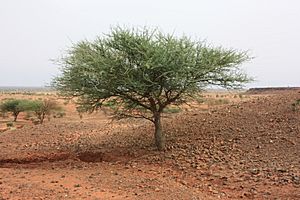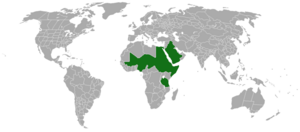Gay acacia facts for kids
Quick facts for kids Gay acacia |
|
|---|---|
 |
|
| Senegalia laeta on a hill near Djibo, Burkina Faso | |
| Scientific classification | |
 |
|
| Range of Senegalia laeta | |
| Synonyms | |
|
Senegalia laeta, also known as the gay acacia or daga, is a type of plant in the Fabaceae family. This family includes many plants that produce legumes, like peas and beans. This plant used to be called Acacia laeta, but it was moved to the Senegalia group.
Contents
What Senegalia laeta Looks Like
Senegalia laeta is a perennial shrub or a small tree. It can grow to be about 4 to 10 meters (13 to 33 feet) tall. Its bark is usually a greyish-green color, but from far away, it can look almost black. If you cut into the bark, you might see a pink color inside.
The leaves of this tree are quite special. They are "twice-pinnate," which means they are divided into smaller parts, and those smaller parts are divided again. Each leaf has 2 to 5 pairs of main sections called pinnae. On each of these pinnae, there are 2 to 5 pairs of tiny leaves called leaflets. These leaflets are oblong (longer than they are wide) and not perfectly even on both sides. They are about 0.6 to 1.2 cm long and 0.3 to 0.5 cm wide. They are greyish-green and mostly smooth, with very few hairs.
These unique leaves help tell Senegalia laeta apart from similar trees. For example, its leaves are different from those of Senegalia dudgeoni, Senegalia senegal, Senegalia gourmaensis, and Senegalia mellifera.
The tree has thorns that usually come in pairs. These thorns curve backward. Sometimes, there's a third thorn that curves forward, but if it's missing, a leaf often grows in its place.
The flowers of Senegalia laeta are creamy white and smell very nice. They grow in groups of three on a stalk, and many of these stalks grow together on a spike. The seed pods are pale brown and feel like leather. They have a pointed end, which is a good way to tell them apart from the pods of Senegalia senegal, which are not pointed.
Where Senegalia laeta Grows
Senegalia laeta is a plant that naturally grows in Africa. You can find it from the Sahara Desert all the way south to Tanzania. It also grows in the Middle East and parts of Western Asia.
How People Use Senegalia laeta
This tree is useful in many ways:
- Dye: Parts of the tree can be used to make dyes for coloring things.
- Animal Food: The leaves and seed pods are good forage for livestock like cows and goats. The tree can handle being eaten by animals without getting too damaged.
- Edible Gum: The tree produces a sticky substance called gum. This gum can be used to make gum arabic, which is used in food and other products. However, the gum from Senegalia laeta is not as high quality as the gum from Senegalia senegal. People collect this gum at the end of the rainy season. It oozes out from the bark and branches. Sometimes, people cut the bark to get more gum.
- Fuel and Building: The wood is used as fuelwood and for making charcoal. It's also used for poles and fence-posts. People use it to build fences around animal enclosures called bomas.
- Ropes and Medicine: The bark from the trunk can be used to make ropes. It's also used to fix broken calabashes (gourds). In traditional medicine, it's thought to help with pain.
- Leather: It can also be used to soften animal hides before they are turned into leather.
- Drought Tolerance: Senegalia laeta can survive well in dry conditions. Because of this, it has been planted in projects to regrow forests in areas that have lost trees.
About the Name of Senegalia laeta
This tree used to be part of the Acacia group of plants. But now, many African acacia species, including this one, have been moved to a different group called Senegalia.
The second part of its scientific name, laeta, comes from a Latin word. In Latin, laeta means "joyful," "cheerful," or "happy."

